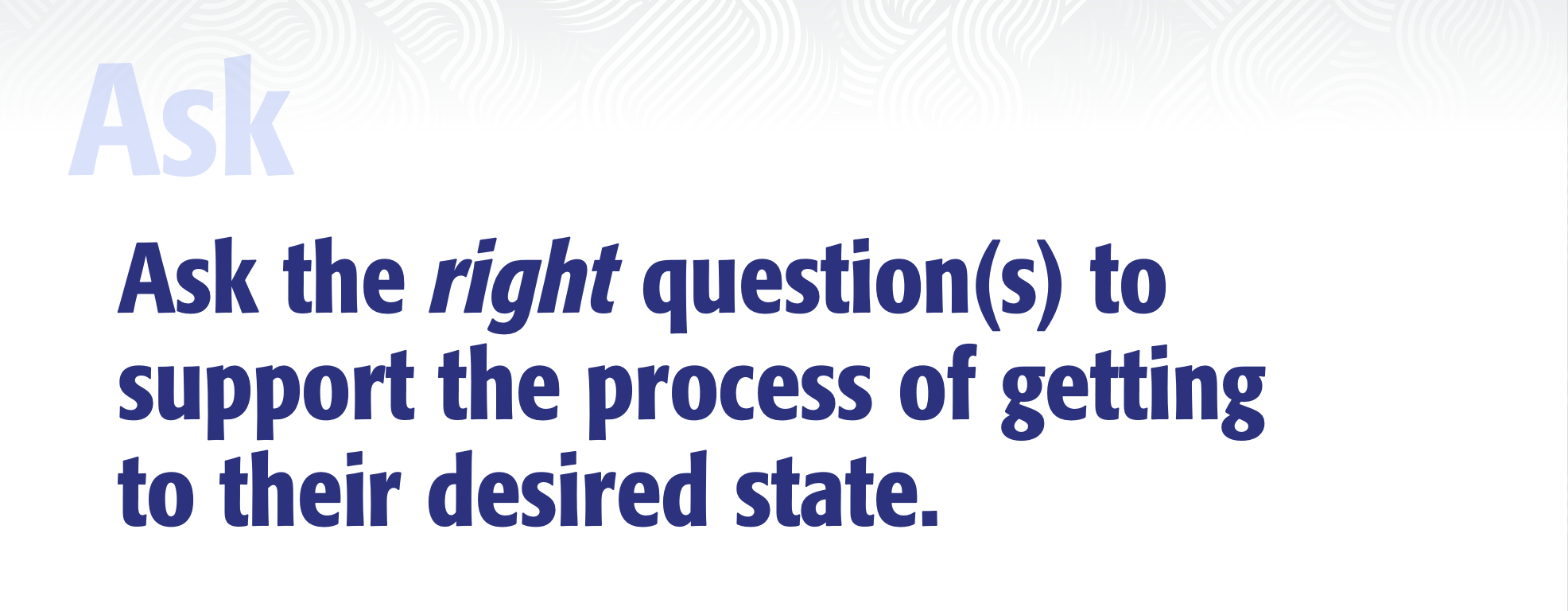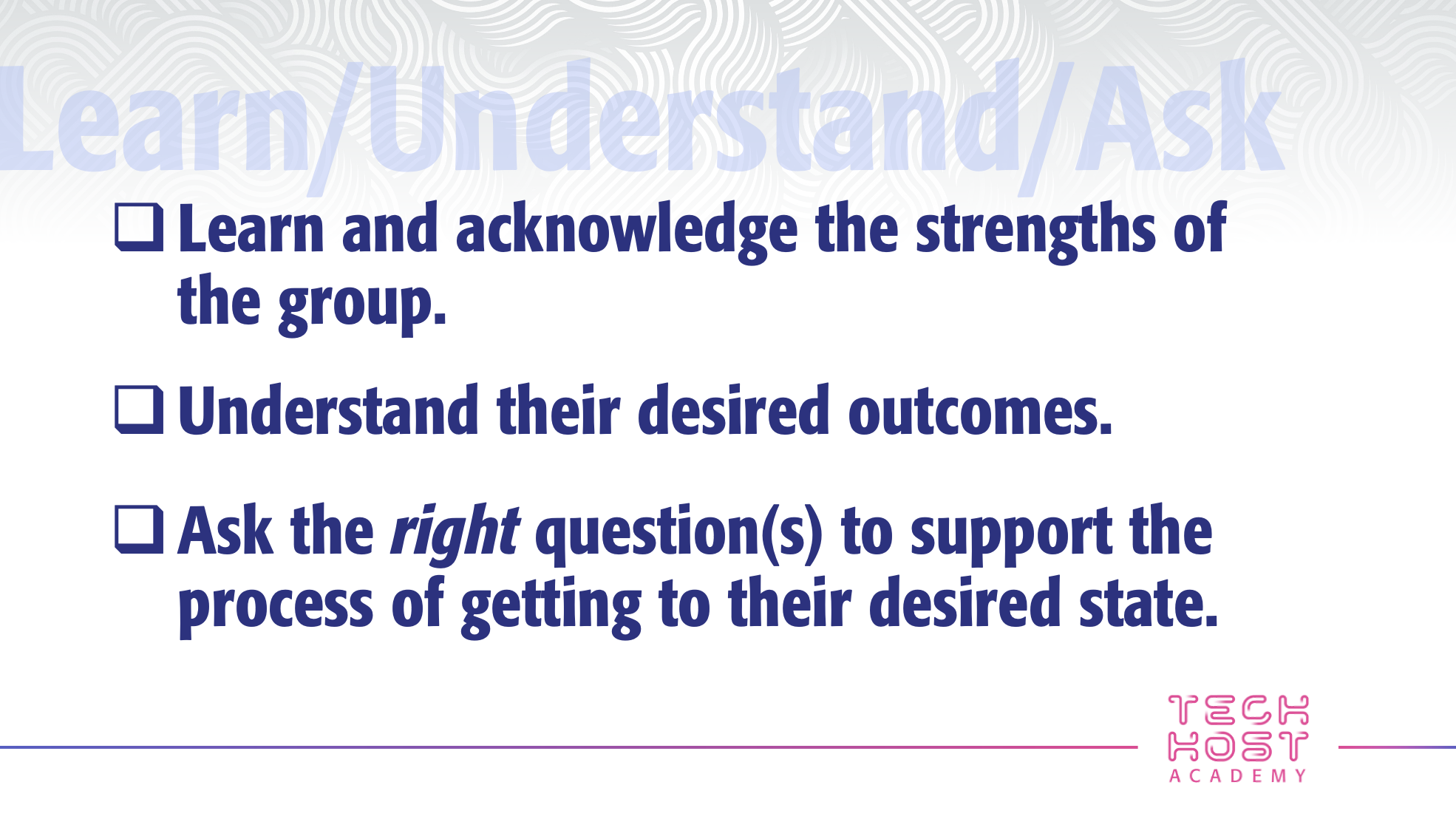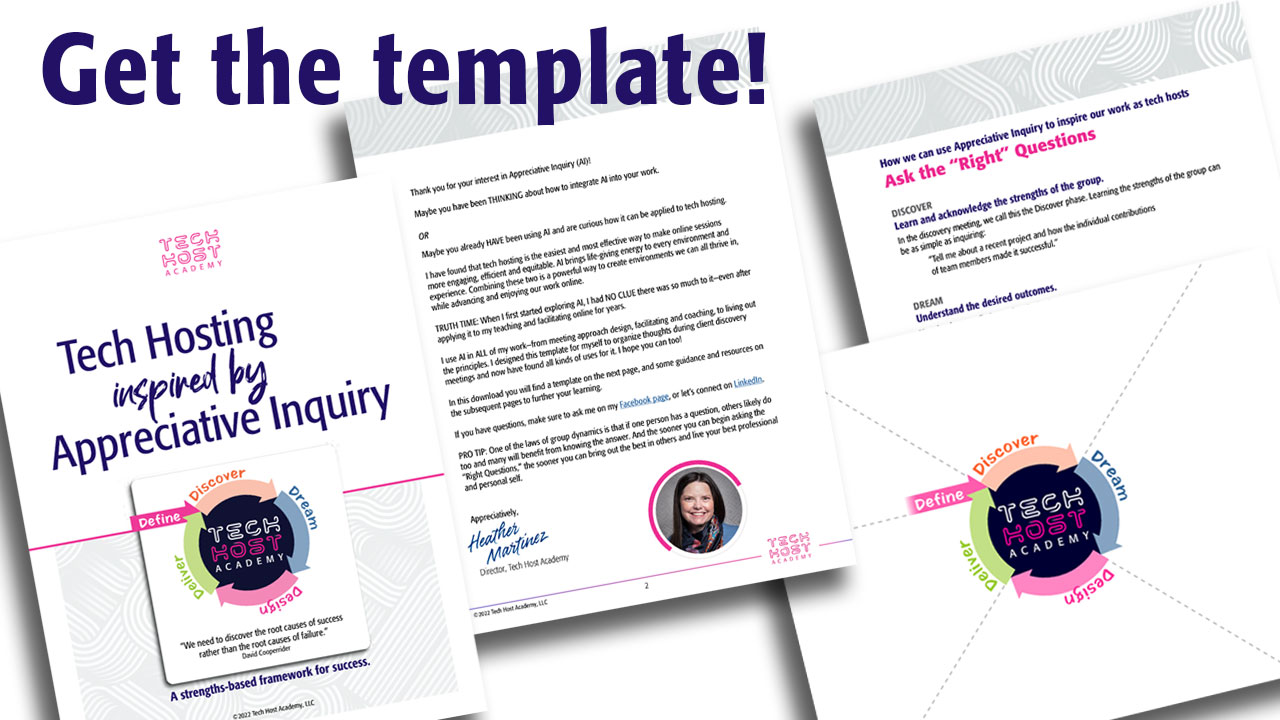Are you asking the "right" questions?
Why are the questions we ask important?
In Appreciative Inquiry, we practice the:
Constructionist Principle: Words create worlds.
Reality, as we know it, is a subjective vs. objective state and socially created through language and conversations.
And according to the co-founder of Appreciative Inquiry, David Cooperrider says:
“We live in the world our questions create.”
If I were to boil down the application of Appreciative Inquiry (AI) into 3 steps, they would be:
- Learn and acknowledge the strengths of the group.
- Understand their desired outcomes.
- Ask the right question(s) to support the process of getting to their desired state.
Now why would I do that? Three simple steps is easy to remember, it’s. mnemonic.
And following these 3 steps have served me well for years.
I just spent the last two weeks doing what I love: tech hosting for my ideal client, which allowed me to witness first-hand expert facilitators train other facilitators in AI, and watch individuals transform right before my eyes by experiencing paradigm shifts. I love being “in the room” when transformation happens.
When I attended the AI facilitator training at the Center of Appreciative Inquiry back in 2016, it changed my life forever. Every conversation after that took a different tone, my relationships improved, my work became more meaningful to me and brought more value to my clients.
Appreciative Inquiry changed me and I use it to help others change, with grace.
Change often doesn’t come natural for some people, while other’s thrive on it. Appreciative Inquiry is much deeper and more widely applicable than what I am proposing here. One thing I learned from my work as a change agent is make it easy. Make it easy to adopt and make it easy to habituate.
Let’s break these steps down into easy tasks. There is a time and a place for everything. The best place to start with a client or to create a new pattern or opportunity with an existing client is in the discovery meeting. You can use the AI Process Template to guide the conversation and gather the information in the discovery meeting. But if you are finding yourself doing the work midstream, meaning the train has already left the station and the opportunity for a discovery meeting has passed, you can still apply these steps.
You can access the AI Process Template here.
In the discovery meeting, we call this the Discover phase. Learning the strengths of the group can be as simple as inquiring:
Tell me about a recent project and how the individual contributions of team members made it successful.
Or, if you find yourself either already on a team or assigned to a project midstream, it will take a shift in your thinking to look for the strengths of others.
Whether you are meeting someone new or have been working with someone for awhile, imaging shining a spotlight on their best attributes.
You can be overt about it by bringing out the best in them by saying something like: “I noticed in our last meeting you…” and then state the value they brought. It validates their effort and encourages more of the positive behavior you observed.
Or you can be more covert with your observations and simply notice the value they contribute. So that you can find ways to support and engage them in the process.
This information will help you in the design of the approach you will take no matter your role:
- team member
- facilitator
- team lead/meeting organizer
- support person/tech host
The next step to inform your approach design is understanding the desired outcome of the client, project, and/or team. 
Here is where we find ourselves in the Dream phase of the 5D AI process.
Understanding the desired outcomes becomes the inspirational glue for all those who share the vision. Or in less woo-woo terms: this defines the WHY.
You can increase understanding by using inquiring:
“What does success look like?”
“How do we want to feel when we reach our goal or by the end of the meeting?”
“How will we know when we are living our purpose?”
Knowing the desired outcomes helps in the design of the delivery. Sharing this within the group fosters equity so that everyone can see themselves in the process and encourages them to bring their best selves.
The next step in the process is the most important. You may have already noticed that we’ve already been doing it. 
Remember the inquiries in the first two steps? What do they have in common? While focuses on the strengths of individuals and the other focuses on what the group wants, both inquiries are structured in such a way that they elicit a positive response. In Appreciative Inquiry, we call this an unconditionally positive question.
Words matter. To form the “right” question, it needs to be structured in a way that is pragmatically generative. Meaning, it supports the desired outcome and takes into account our combined strengths.
In the recent article published by FastCompany, “Hybrid work isn’t working: Here’s a better approach” c-suite executives of Rocketbook faced with the challenge of making the decision between having an all, in-person company or remote chose to adopt a “both/and thinking” approach to develop a more creative and productive solution.
They asked the question, “How can we make virtual and in person work best?”
The article goes into how their design met their desired outcomes and what they did and others can do to ensure equity while keeping employees engaged and foster productive collaboration.
In Appreciative Inquiry, the fifth phase is called Deliver or Destiny. We get there by following the first four, but it doesn’t stop there. We leverage the success, lessons learned, and all that we have gained to begin again. AI is an adaptive change process that builds on our ability to:

These three simple steps are easy to adopt and can improve both your professional and personal life.
And while we are on the subject of asking the right questions, here are a few others you might consider:
For yourself:
What can I do today that I enjoy, am good at, and that will move the needle closer to where I want to be?
For a significant other in your life:
What can I do to help you make your day better?
This encourages them to ask for what they want and helps you know.
And for the future:
What seed can I plant for a better tomorrow?
How good does that feel?
If you want to bring that feel good vibe into your practice as a facilitator or tech host, you can learn more at Tech Host Academy where we live into AI to develop our Presence and customize our approach design all while mastering the tech to create online environments we can all thrive in. You can get on the waitlist to enroll here.
And you can download the Appreciative Inquiry 5D process template for tech hosting here.

Heather Leavitt Martinez uses Appreciative Inquiry in all of her work—from meeting approach design, facilitating and coaching, to living out the principles. She teaches relevant, applicable techniques to apply AI to tech hosting at Tech Host Academy and combines it with visuals in her course: “AI + Visuals: Meeting Approach Design” at the Center of Appreciative Inquiry.
Want a behind-the-scenes pass to learn what it takes to be a professional tech host?
Check out the free training webinar:
How to Create Thriving Online Environments
without needing to Be a Tech Geek
No offense tech geeks! We love you!


